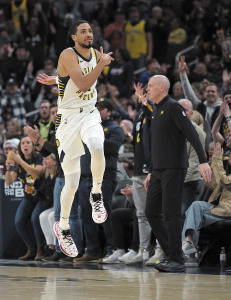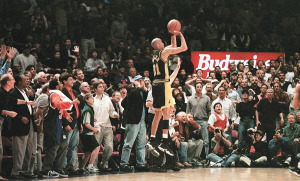Subscriber Benefit
As a subscriber you can listen to articles at work, in the car, or while you work out. Subscribe Now Three is more than two. We can agree on that much, right?
Three is more than two. We can agree on that much, right?
Quite simply, then, that’s why the 3-point field goal has infiltrated and overwhelmed the NBA, where the players have essentially hacked the game with their shooting accuracy and fire away with scant regard for volume and distance. Shots that once were nicknamed home runs because of their rarity and distance are now sprayed like singles.
Whether this is a good thing for basketball is open for debate. Some fans, especially older ones, complain about the barrage of 3-point shots raining from the rafters, believing they have turned games into long-distance shooting contests. They nostalgically recall the more physical, slower-paced games of their youth, with centers standing with their backs to the basket and generating offense with shots or passes from about 8 feet away.
Inside-out offense they called that, and it was widely accepted as the best way to play until about 20 years ago. The Pacers took that approach with Reggie Miller and Rik Smits for more than a decade and reached the conference finals five times in a seven-year period from 1994-2000, but that’s now even more outdated than wearing a white uniform for every home game.
The transformation of the NBA game from dropping well-placed hand grenades to exercising long-range bombing missions has been stunning when viewed from afar. For example:
◗ The Pacers’ most successful NBA team, the one that reached the finals in 2000, led the league in 3-point accuracy (.392). Twenty-two percent of its overall field goal attempts were 3-point shots.
◗ This season’s team, which leads the NBA in scoring, ranked fifth in 3-point accuracy (.387) heading into Wednesday’s game against New Orleans, but 39% of its attempts were 3-pointers. The Pacers were taking 35.7 per game. The 2000 finals team took 18 per game, a franchise record at the time.
◗ The six teams Bob “Slick” Leonard coached for a full season in the ABA all ranked first or second in 3-point attempts in that league. But despite the ABA’s reputation for playing a wide-open game, it was buttoned-down conservative by today’s standards. The Pacers team that won the 1973 championship attempted 551 3-pointers all season—just 6.6 per game. That probably was a good idea, though. It hit just 31% of them.
Desperate moments
The 3-point shot disappeared for four seasons after the ABA folded, and four of its teams were absorbed into the NBA. The shot was brought back for the 1979-1980 NBA season but was barely a rumor for a while, a seldom-used unreliable weapon saved for desperate moments.
The Pacers, for example, attempted just 143 3-pointers in the 1985-1986 season—just 1.7 per game. They hit just 16% of them, 23 total for the season. They made 22 in a game at Atlanta earlier this season.
Steph Curry alone has taken more 3-pointers so far this season than did entire Pacers teams in any of their first 10 NBA seasons.

For many older purists, standing back and firing 3-pointers seems like cheating, or at least taking a shortcut—a way to circumnavigate the tougher task of patiently working the ball inside and battling for shots close to the basket. Meant to be spice to an offense, the shot has practically become its bread and butter.
For coaches, however, it’s the only logical way to play.
“Shot value,” Pacers coach Rick Carlisle calls it.
“If you can get good catch-and-shoot 3’s, that’s the second-best shot in basketball next to a layup,” he said.
In other words, why take an 18-footer for two points when you get three points for a shot from beyond 23 feet, 9 inches? Critics of the shot’s pervasive influence often fail to understand how much better the shooters are today. The Pacers didn’t have a bona-fide 40% 3-point marksman—meaning one who took attempts to qualify for the league rankings—until Reggie Miller did it in the 1988-1989 season.
They currently have four shooting better than 40%. Two others are over 38%. and one of those, Tyrese Haliburton, has been over 40 most of the season. He is the team’s most prolific shooter, taking 7.8 3-pointers per game. Myles Turner, meanwhile, is typical of the modern NBA center. He is a legitimate threat, too, hitting 33% of his attempts. That equates to making 50% of two-point attempts.
Adapting to change
Carlisle, who played in the NBA in the 1980s and has coached in it since 1989, has adapted to the changes. He easily recalls the physical, slow-paced games of the late ’90s and into the next decade when the league had what he calls “a scoring crisis.” He would know. He coached the Pacers into the conference finals in 2004, where they scored 78, 67, 78, 83, 65 and 65 points in a six-game loss to Detroit.
Rules changes enabled offenses to flow more, then shooters such as Curry broke the mold by shooting farther and farther from the basket, past 30 feet with great frequency and accuracy.
“It forced the game to become more of a ball-movement game, more of a skill game and less of a pound-the-ball-inside game and less of an iso game,” Carlisle said. “What people started to realize was that the 3-point shot was kind of an undiscovered gem.
“It’s really evolved the NBA game to the point the level of skills and confidence are at an all-time high.”
Good luck to the coach who doesn’t bow to the 3-point gods. Nate McMillan didn’t and paid for it with his job. His final Pacers team went 45-28 in the 2019-2020 season and qualified for the playoffs. It was strong defensively, allowing fewer points than all but two teams in the league. But it ranked last in 3-point attempts and second-to-last in made 3-pointers.
His players were frustrated with his old-fashioned system when they were swept by Miami in the first round of the playoffs, and he was let go.
Outside the NBA
The 3-pointer is not as predominant in the college game as in the NBA, but it’s a mandatory asset for any team hoping to win big. Purdue, the No. 2 team in the country this week, understands that. Failure to take advantage of the shot was a major contributor to each of its losses: Northwestern, Nebraska and Ohio State. It was outscored by a total of 30 points on 3-pointers in those games.
The downside of trying to score three points at a time is that it has led to homogenization, particularly in the NBA, where teams usually initiate their half-court offense with a weave or by running a pick and roll near the 3-point line. In that respect, the NBA game has become like the Indianapolis 500: The cars are obviously better—faster and safer—but essentially alike, making the race less interesting for many fans.
“There’s not a whole lot of different types of offense,” said former Pacer Bill Keller, a 3-point specialist in the ABA. “It seems like it’s pick and roll, pick and roll … that, to me, gets old. The girls’ games seem to have more in their offensive repertoire than pick and rolls.”
Jerry Sichting played 10 seasons in the NBA, five with the Pacers, and was an assistant coach for various teams for 22 seasons. He said he understands the reason for the current style of play—“they’re better shooters now”—but misses the variety of offensive systems that once dotted the NBA landscape and the strategies that went into attacking a mismatch.
“I’m still kind of up in the air about it,” Sichting said. “It’s made the game look like it’s disorganized and just glorified AAU basketball. I don’t watch nearly as much NBA as I watch college now, and it used to be the opposite.
“They’re going by analytics; I understand that. But the game has always changed. You look at film of games when I played [in the ’80s] compared to the games from the ’60s, and they are totally different. Now it’s totally different again. Change is inevitable.”
It’s about skill
Love it or not, give the 3-point shot credit for producing many of the greatest highlights in the Pacers’ history.
◗ Jerry Harkness hit the longest game-winning shot in basketball history by heaving an 88-footer at the final buzzer for a 119-118 victory at Dallas on Nov. 13, 1967.
◗ Roger Brown hit seven 3-pointers in 12 attempts while scoring 45 points when the Pacers clinched their first ABA title in Game 6 of the 1970 finals in Los Angeles against the Stars.
◗ Keller hit nine 3-pointers in a playoff victory over San Antonio in 1974. He hit two more that didn’t count, one because he was ruled out of bounds and another that came just after the final buzzer.
◗ Miller hit five of them in his 25-point barrage in the fourth quarter of a playoff victory over the Knicks in Madison Square Garden in 1994.
◗ Miller hit two within a few seconds of one another in his legendary eight-points-in-8.9 seconds spree at the Garden in the 1995 playoffs.
◗ Miller hit another one to force overtime in a playoff game at the Garden in 1998. The photograph showing New York fans shouting in dismay as Miller went up for his shot has become iconic.

There will be more like those, because the 3-point shot isn’t going anywhere soon, if ever. Moving the line farther from the basket isn’t an option because it would require enlarging the court, which would require a major remodeling of many arenas. “That’s a non-starter,” Carlisle said.
Doubting fans will have to learn to like the shot or look the other way. Carlisle suggests giving in.
“Not only are [today’s players] guys who can make 3’s, they can dribble, pass, shoot and make plays,” he said. “The game has become a beautiful demonstration of skills on a night-in, night-out basis. It’s at a crescendo.”
“If you choose not to celebrate that, that’s a personal decision, but why shouldn’t any sport be about skill from the offensive standpoint?”•
__________
Montieth, an Indianapolis native, is a longtime newspaper reporter and freelance writer. He is the author of three books.
Please enable JavaScript to view this content.

I can now watch NBA basketball again and enjoy it. 10-25 years ago with the emphasis on the inside game I couldn’t watch. They do need to improve the inside defense though, way too many easy inside shots and layups are being allowed.
Good analysis as always. The old ABA game seemed more wide open with graceful players like Dr J. I think the defensive Bad Boy teams of Detroit in the 80’s were awful to watch. They made it dangerous to go to the basket for a layup.